
 |
|||||
|
|
|||||
|
|
|
|||||
|
|
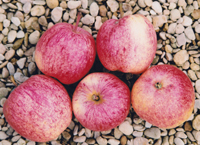 |
MAIDEN'S BLUSH There are three different apples with this name; a British one, an Irish one and an American one. This is the British one, a middle season dessert apple from Herefordshire. It is probably old, but recorded history only goes back to 1935. Crisp and sweet, very juicy when fresh, and lasting until November. A pretty apple with delicate red streaks. Pollination Group 8 |
||
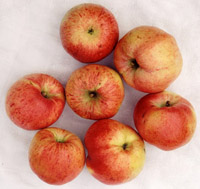 |
MALTSTER First recorded in 1830, it was popular and widely grown around Nottinghamshire. It is a vigorous grower and prolific bearer. The medium sized apples are crisp and juicy and useful for both culinary or dessert purposes, with a sweet, rich and fresh flavour when eaten raw and keeping their shape when cooked. Ripe in September, the apples store into November, still firm and juicy. Deep pink buds and full pink blossom. Part tip bearing but also free spurring. Pollination Group 4 |
|||
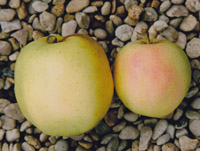 |
MANKS
CODLIN This apple was raised by Mr Kewley at Ballanard, Isle
of Man, reportedly first fruiting in 1815, but the Backhouse Nursery,
in York, had it in their catalogue in 1816, so it must have existed earlier.
Included in the London Horticultural Society collection in 1826, it has
been well recorded since. A good early cooking apple, therefore valued
in the North and Scotland where most other fruits ripened later. It is
also said to do well in exposed places, on shallow and poor soils, though
it is not particularly vigorous. Rogers (1837) said this keeps better
than all the other codlins. A medium-sized (though Scott said it was large)
fruit, conical and slightly angular. The smooth, green/yellow skin becomes
paler with a blush of pink or orange-red in the sun. The flesh is yellow-white,
firm, juicy and perfumed. It breaks down when cooked. Spreading habit.
Pretty blossom. Pollination Group 2 |
|||
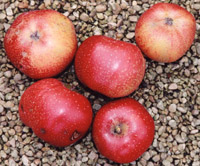 |
MANNINGTON’S
PEARMAIN This was thought to have originated from the seeds of
a cider apple, thrown into the hedge, around 1770, by a Sussex blacksmith,
who was Mannington’s grandfather. Mannington sent it to the London
Horticultural Society in 1847, and it became a popular dessert apple.
Crisp, juicy, richly flavoured flesh. Precocious bearer and good crops.
Stores until February and though it shrinks, it remains very juicy and
rich. Free spurring. Pollination Group 4 |
|||
 |
MARBLE Brought over from America by us, for observation to see if it might be the old ‘lost’ Marbled Pippin, but it seems not. Nevertheless it is a very good apple indeed and well suited to our climate. A medium sized, lightly ribbed apple ripe in September. It is a very pretty apple, with broad red stripes marbled over yellow, and with refreshingly juicy, sweet and rich flesh. It stays in good condition for a month or two. Pollination Group 3 | |||
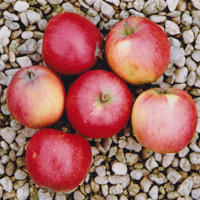 |
MARGARET
An old English apple, first mentioned in 1665, though it is thought to
be much older. It became known all over Europe and North America. Often
confused with the Joanetings, and sometimes called Early Red Margaret,
it ripens slightly later than the Joanetings. The name was thought to
come from its ripening close to St. Margaret’s Day, though it is
unlikely it was St Margaret of Scotland, whose feast day was in June,
and more likely St Margaret of Antioch, whose Day was in July. Small,
brightly coloured, juicy fruit. Like many early apples, it is best eaten
when first ripe, when it has juicy, rich, aromatic flesh. It is best to
pick it just before they fall. Margaret is often grown as a cordon or
espalier, as the trees are not vigorous. Once very widely grown. Pollination
Group 4 |
|||
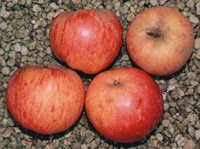 |
MARGIL
Also called Reinette Musquée, Small Ribston, Never Fail. A very
old dessert apple, possibly first introduced from France by George London,
who had worked in the gardens at Versailles. He was a partner in the Brompton
Park Nursery, Surrey, where this apple was extensively cultivated as early
as 1750. Small golden fruit with broad red stripes and russet patches,
and with a quite exceptional concentration of flavour, sweet and aromatic,
especially after a warm summer. One of Bunyard's top ten apples for the
epicure. Small trees, which are very hardy and produce good crops. Pollination
Group 3 |
|||
MARIANNE
A curious and very old tree owned by Marion Hebblethwaite, artist of East
End, near Witney and the Roman Villa of North Leigh, Oxfordshire. Marion
brought us apples several years ago and they have defied identification.
Her house dates back to 1700 and is surrounded by old stone quarry workings
around her property. The stone was used for the Oxford Colleges, but the
quarry closed around 1860-1880. Though very old and hollow her apple tree
was extremely small – barely 6 feet tall. Perhaps it was dwarfed
by stone beneath the topsoil, but it seemed naturally inclined to modest
growth. Unfortunately her tree has now died. The apples are early to mid
season, prettily striped and very rich and juicy. Ripe from August to
September, they retain their flavour if kept, but are inclined to shrink
in November. The name was given by Marion. A good apple and a reliable
cropper. Pollination Group 5 |
||||
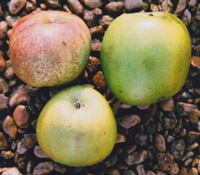 |
MARKET
BOSWORTH PARK Lee Taylor of Market Bosworth in Warwickshire was
aware of this old tree in Market Bosworth Park, and sent us apples in
2013. They were barely ripe when sent on the 8th November, so it is a
very late ripening apple. He records that the tree was originally 30-40ft
tall but the top had been taken out by wind. The apples are small, yellow,
sometimes with a pale pink blush and very sweet and crisp. They will last
with careful storage to March. A very good apple, if left to mature fully.
Pollination Group 6 |
|||
|
||||